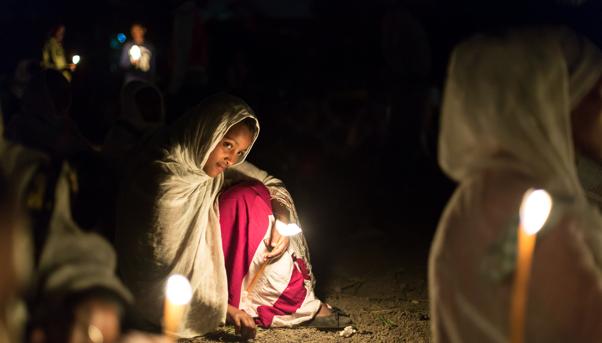
Thirteen years after the first “International Conference on Financing Development” that was held at Monterrey, Mexico, it was Addis Ababa’s turn on July 13, 2015.
It was not just a mere coincidence, but a strong message. In fact, with regard to the large projects launched by the United Nations like the “Millenium Development Goals”, Addis Ababa (the city where the African Unions’ headquarters are based) and the whole of Ethiopia, represent, as of today, a symbol and an example for the whole world. This has also been stressed by Jim Yong Kim, Chairman of the World Bank, who has pointed out how the Addis Ababa international conference could change the lives of billions of people in the world.
So this conference, which was held to discuss the new world development guidelines, and which was attended by representatives of the most important global institutions, starting from UN Secretary General Ban Ki-moon, served as an acknowledgement for a country that has been growing rapidly during the years and will probably represent the driving force of the African continent.
Ethiopia: a growing country
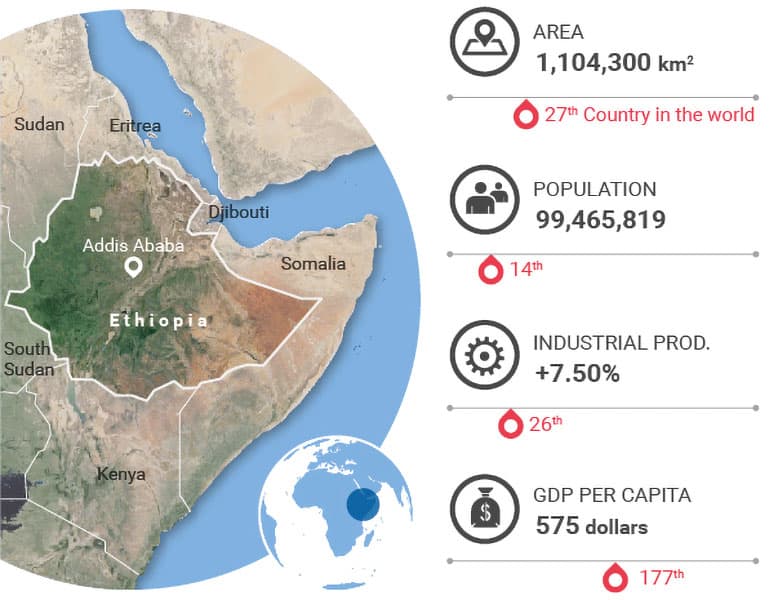
The world’s factory
In the Bole Lami district, two steps away from Addis Ababa, factories just seem to be ever-growing. Small industrial areas where companies from Pakistan, India, Taiwan, Korea and Bangladesh produce all sorts of products, for the internal market and for the international one. There is also a strong presence of Chinese companies, located in the “eastern industrial area”, a flat 5-square-kilometer area where, since 2007, workers in small factories work day and night producing every type of product, from leather to steel.
The country has eight large industrial parks. They are mainly located near the larger cities. The first industrial park to be realised was nearly entirely occupied by Chinese companies and destined for export. In a country with more than 90 million inhabitants, many young and illiterate, work is a central topic and qualified labour a guarantee for the international giants that choose to invest abroad. Just like Ayka Addis did, a textile giant that established itself 30 km south of the capital, building the largest factory in Ethiopia, where 8,000 young Ethiopians work. This is the new Ethiopia and the most ambitious challenge of the Ethiopian government: to pass from a village economy to an urban one, transforming the traditionally agricultural territory into a «middle income country», a country with a middle class with average wages.
GDP continually growing
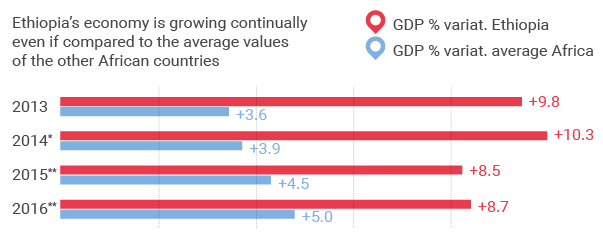
The term for reaching the objective, according to the plans that have been arranged with the International Monetary Fund and the World Bank, is 2025. From now to then, the country’s economy should continue to grow with an annual growth rate that varies between 11-15%, a real race for increased growth, which will contribute in bringing to an end the profound social and cultural changes that are still occurring.
The Industry and Training
The Ethiopian industrial push is a driving force of the country’s economy, but not the only one. The government has, in fact, identified six strategic sectors on which to invest so as to reach the objectives set for 2025. Institutions, in addition to improving the industrial area, are aiming at taking agriculture, urban transport, constructions and urbanisation, services and access to healthcare and education services to another level.
Education and training are a necessary step for many young Ethiopians, who are taken into account by various foreign multinational companies exactly for their high literacy levels. Ethiopia has 45 universities with a total of 500,000 students. Engineers, doctors, R&D experts graduate every year, young people offering technical and scientific know-how, exactly what the market is looking for.
A fast moving economy
The path towards a country where agriculture still generates 42.3% of the country’s GDP and occupies 80% of the workforce, is still very long and complex.
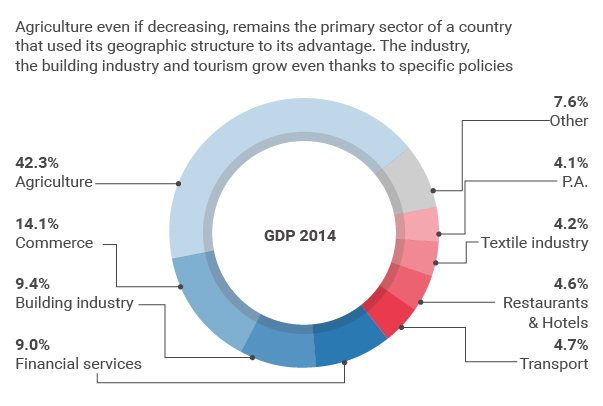
Still, in the last 10 years the Ethiopian economy has run really fast, as fast – if not faster – than the Chinese and Indian economies. The IMF places Ethiopia among the five fastest growing economies in the world.

In 2014, the country’s economy for the 11th consecutive year has reached double-digit growth (+10,3%), a trend that will likely be confirmed at the end of this year. In particular, according to the “Ethiopia 2015” Report, which was published by the United Nations and the Organisation for Economic Co-operation and Development (OECD) – while agriculture and services grow at a “normal” pace, it is the industrial sector with its +21.2% that boosts the growth figures. This is mainly due to the public investment policy adopted by the local government.
«During the last 10 years – says Haile Kibret, Economics Specialist of the United Nations – the public sector has guided the country’s development thanks to the gigantic investments made in the infrastructure sector”. This development has benefited both the urban and rural communities. A tendency that contributed to the creation of many new jobs, especially in the construction sector and more generally in the infrastructure one. The large infrastructure projects started in the last years are not limited to promoting growth, but also provide their precious contribution in order to reach another objective: to transform Ethiopia into Africa’s number one energy country.
The water tower of Africa
Once the tests have been concluded, starting from October 2015, one of the 10 turbines with 187 MW of power at the Gibe III will begin to produce energy. The hydroelectric plant built by Salini Impregilo on the Omo River is at the moment the largest in Africa. It will have an outgoing power of 1,870 MW and a capacity of 14 billion m3.
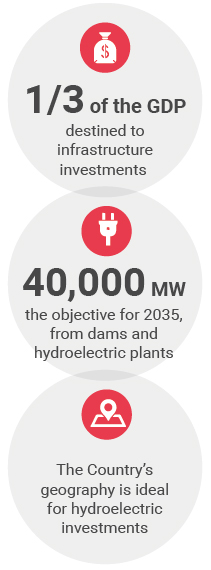
Gibe III is but one of the dams that will transform Ethiopia into the energy hub of the African continent. The country, today, exports energy to Kenya, Sudan and Djibouti, the states that are geographically closer. The authorities do not exclude that the potential production of the hydroelectric plants under construction will allow power to reach even the most distant markets, like Europe and the Middle East. In order to reach this result, Ethiopia is investing a sum (€12 billion) that amounts to a third of its GDP for the construction of infrastructures capable of producing hydroelectric energy. These works will make use of the power of the rivers that flow from the Ethiopian mountains, and will be able to generate 40,000 MW of hydroelectric energy by 2035. A plan that is linked to the Millenium Development Goals (the development objectives set by the United Nations to eliminate poverty in the world), and which has been made possible, mainly due to the hydrographic formation of the country. For this specific reason it has been described as “The Water Tower of Africa”.
Its territory is varied: there are places that are 110 m below sea level, like the “Denakil Depression” in the northeast of the country to 4,600 m above sea level in the Simien Mountains up in the north. An indented configuration where 12 main rivers flow and that each year transport an average of 122 km3 of water. This is the reason why the Ethiopian government decided to make the most of the country’s water-produced power, a project of which Salini Impregilo is one of the greatest partners because, from the first dams built, like Legadadi, Beles, GIBE I and GIBE II, the company has been present in the country for the construction of large infrastructures, up to the last and most ambitious one: the Grand Ethiopian Renaissance Dam.
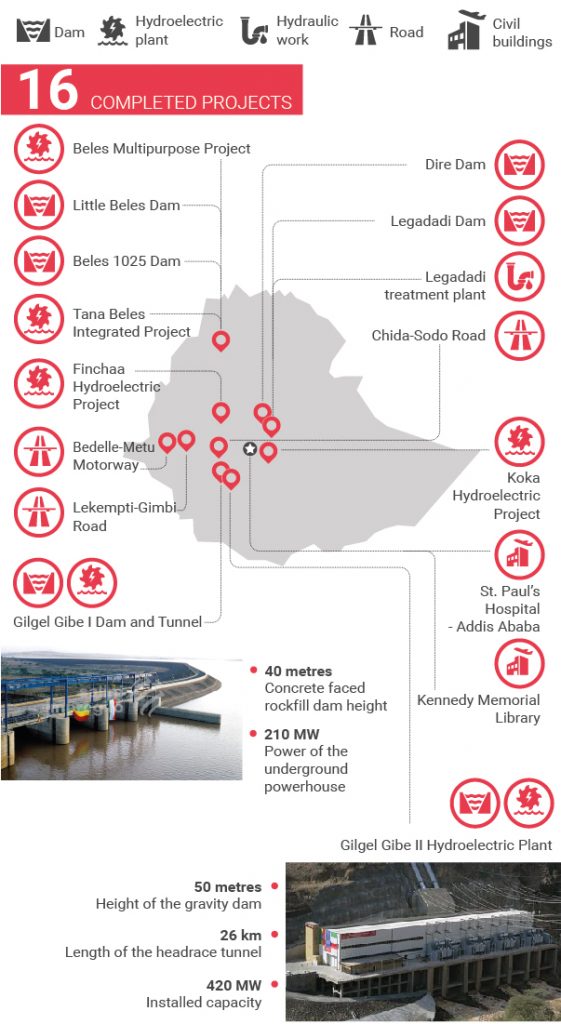
The GERD worksite, 500 km north of Addis Ababa, directly and indirectly, employs approximately 15,000 people, who are all engaged in finishing the work by 2017. Once finished, the dam will be the largest in the African continent, entirely built on the Blue Nile’s waters. The GERD dam, once up and running, will produce 6,000 MW of electricity, while the artificial lake will cover an area of 1,874 km2.
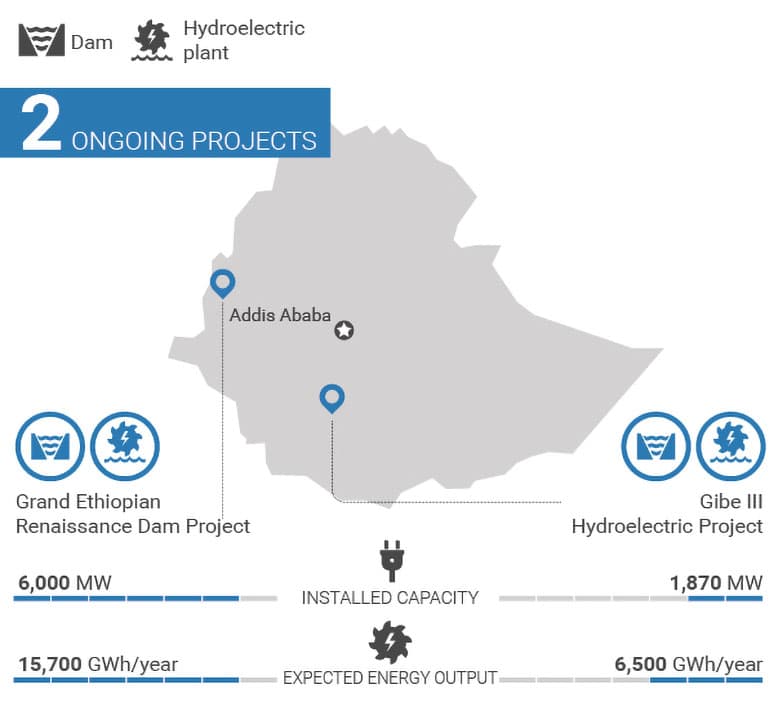
GERD is a “vision”, a shared expectation of a work that could contribute to reduce poverty, social clashes, economic backwardness. But most of all it is a symbol, as recently stated by the Prime Minister Hailemariam Desalegn, of the environmental recovery of Ethiopia, a country that aims at becoming carbon neutral by 2025, especially through its gigantic hydroelectric projects. In doing so, Ethiopia will provide a modern and effective answer for its development. This is a political vision that was already adopted by Ethiopia’s ex-prime minister, Meles Zenawi, a historical figure and leader of the Ethiopian’s People Revolutionary Democratic Front, which could be used as a driving-force for other African countries, promoting the continent’s recovery that has been awaited by many.

